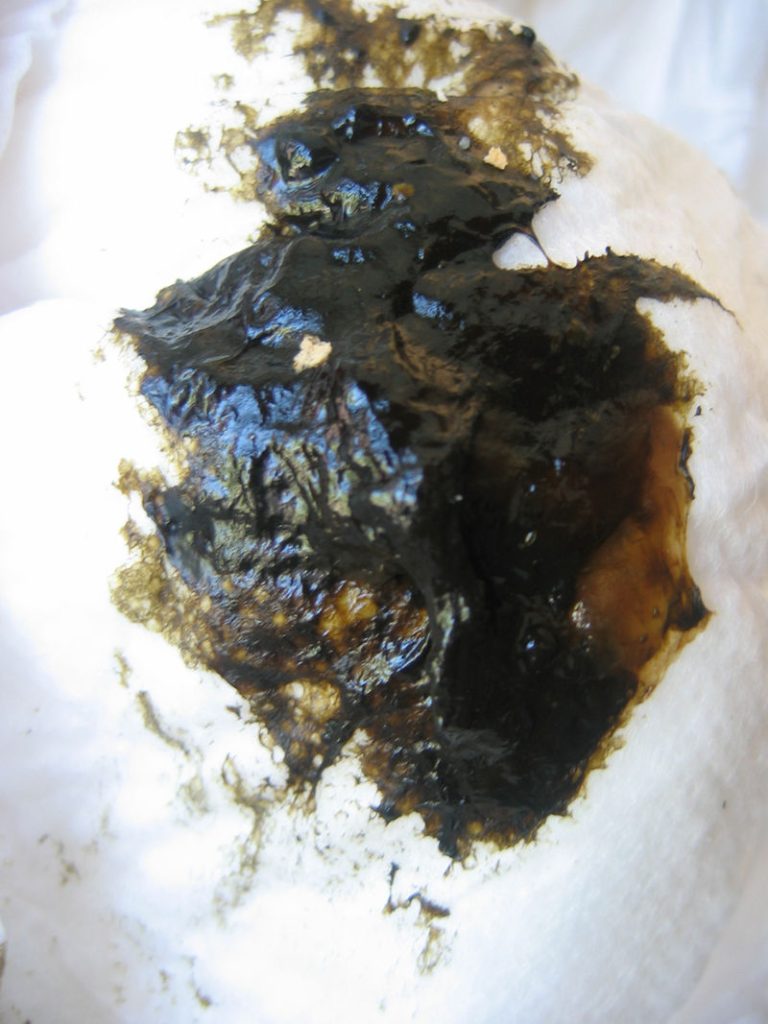Meconium Aspiration
Published (updated: ).

Meconium is the earliest stool of a newborn. Occasionally, newborns pass meconium during labor or delivery, resulting in a meconium-stained amniotic fluid (MSAF). Meconium aspiration syndrome (MAS) is the neonatal respiratory distress that occurs in a newborn in the context of MSAF when respiratory symptoms cannot be attributed to another etiology. The spectrum of manifestations associated with meconium aspiration is broad, ranging from mild distress to more severe respiratory failure. More life-threatening conditions have been recognized to also be associated with MAS, notably persistent pulmonary hypertension of the newborn (PPHN), and air leak syndromes.
Etiology
MAS is due to the aspiration of meconium-stained amniotic fluid. MASF is not an uncommon finding and is not always associated with MAS. Uterine stress due to hypoxia or infection can cause early fetal meconium passage. Unlike infant stool, meconium is darker and thicker. It is formed through the accumulation of fetal cellular debris (skin, gastrointestinal, hair) and secretions. Aspiration of these materials causes airway obstruction, triggers inflammatory changes, and inactivates surfactant. Through these mechanisms, the neonate develops respiratory distress.
Pathophysiology
The pathophysiology of MAS is not completely understood, however, 5 important processes have been described: Meconium passage, aspiration, airway obstruction, inflammation, and surfactant inactivation.
- Meconium passage: Usually, fecal defecation rarely happens between 20 and 34 weeks of gestation. It was noticed that in utero meconium passage is more common in late-term and post-term babies after 37 weeks of gestation. Several mechanisms have been hypothesized to play a role in the process, including increased peristalsis, anal sphincter relaxation, and changes in vagal and sympathetic tones in the context of fetal distress and hypoxia.
- Aspiration: During the delivery process, fetal breathing usually leads to amniotic fluid moving in and out of the lungs. When amniotic fluid is stained with meconium, the fetus is at risk of aspiration. This is especially true with hypoxia that can trigger the fetus to increase gasping, which leads to more amniotic fluid inhalation by the fetal airway.
- Airway obstruction: As meconium is thick and the fetal airways are small in diameter, the presence of meconium in the airways can cause obstruction. The mechanism is similar to a foreign body aspiration. The meconium plug can cause complete obstruction leading to lung collapse distally as well as atelectasis. When partial obstruction occurs, it causes a ball valve effect with increased air trapping, thus increasing the risk of air leak syndromes, notably pneumothorax. Recent data suggest that airway obstruction does not always happen in the context of MSAF and that obstruction alone does not completely explain MAS.
- Inflammation: Inflammation plays an important role in the pathogenesis of MAS. Material that constitutes meconium has been shown to trigger inflammatory processes that further contribute to the development of respiratory distress in MAS. Airway inflammation results in a form of chemical pneumonitis.
- Surfactant inactivation: Inflammation and hydrolysis can alter and inactivate surfactant. This leads to increased surface tension, poor compliance, and impaired oxygenation. Thus, further contributing to the respiratory distress seen in MAS.
All these processes lead to a decrease in alveolar ventilation, causing increased ventilation-perfusion mismatch. This is the main cause of hypoxemia in infants with MAS. Prolonged hypoxemia will trigger pulmonary vascular constriction, which in turn increases pulmonary vascular resistance (PVR).
History and Physical
Relevant History for MAS Diagnosis
- A term or post-term newborn
- Neonatal respiratory distress not otherwise explained
- Meconium-stained amniotic fluid
Important Findings to Note on Physical Exam That Can Be Present With MAS
- Signs of postmaturity: Vernix, peeling skin, long fingernails
- Signs of respiratory distress at birth: Bradycardia, hypoxemia, cyanosis, and tachypnea
- Birth depression: Limp or non-vigorous baby
- Meconium stained amniotic fluid and meconium-stain on physical exam
Treatment / Management
MAS management is mainly supportive, but early identification and support can improve outcomes and decrease morbidity and mortality.
- Oxygen therapy: Supplemental oxygen is often needed in MAS with goal oxygen saturation > 90% to prevent tissue hypoxia and improve oxygenation. Hypoxemia is an important trigger of pulmonary vasoconstriction, which can increase PVR.
- Ventilatory support: This is indicated with refractory hypoxemia despite oxygen therapy, carbon dioxide retention, and increased respiratory distress. There are no specific ventilation strategies. Oxygenation monitoring and serial ABG to help optimize oxygenation and ventilation are key.
Differential Diagnosis
The differential diagnosis for MAS includes other causes of newborn distress:
- Respiratory distress syndrome: This is more common in a preterm infant.
- Transient tachypnea of the newborn: This usually resolves within 72 hours.
- Sepsis/infection/pneumonia: Any newborn with distress should be assessed for infections.
- Congenital heart disease: Usually diagnosed with an echocardiogram.
Prognosis
Mortality in MAS is close to 1.2 percent based on a large retrospective study in the United States, this is lower than the mortality reported in developing countries. The majority of infants recover with a good prognosis.
